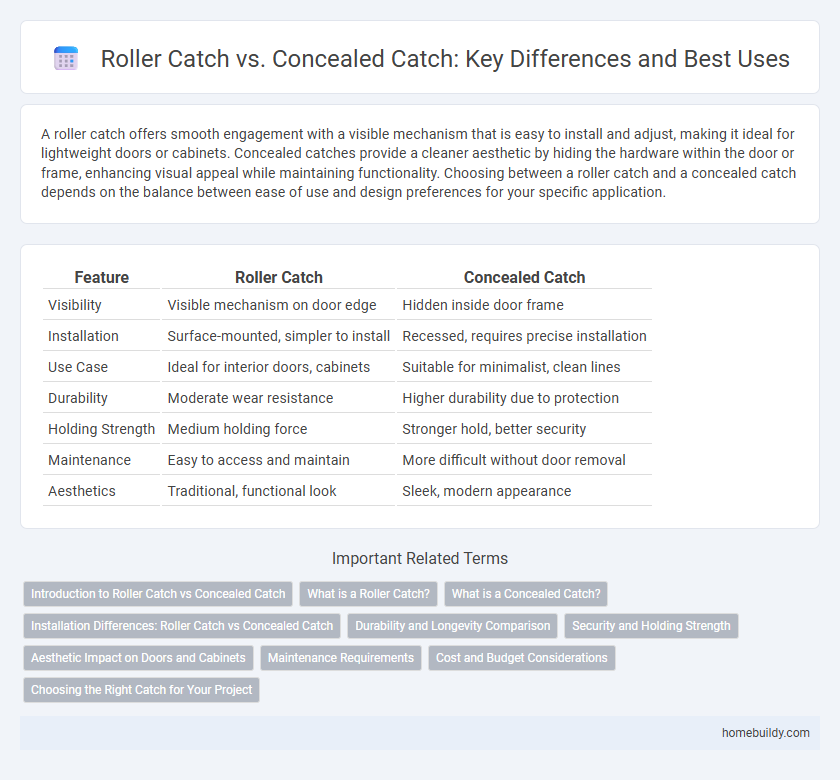A roller catch offers smooth engagement with a visible mechanism that is easy to install and adjust, making it ideal for lightweight doors or cabinets. Concealed catches provide a cleaner aesthetic by hiding the hardware within the door or frame, enhancing visual appeal while maintaining functionality. Choosing between a roller catch and a concealed catch depends on the balance between ease of use and design preferences for your specific application.
Table of Comparison
| Feature | Roller Catch | Concealed Catch |
|---|---|---|
| Visibility | Visible mechanism on door edge | Hidden inside door frame |
| Installation | Surface-mounted, simpler to install | Recessed, requires precise installation |
| Use Case | Ideal for interior doors, cabinets | Suitable for minimalist, clean lines |
| Durability | Moderate wear resistance | Higher durability due to protection |
| Holding Strength | Medium holding force | Stronger hold, better security |
| Maintenance | Easy to access and maintain | More difficult without door removal |
| Aesthetics | Traditional, functional look | Sleek, modern appearance |
Introduction to Roller Catch vs Concealed Catch
Roller catches use spring-loaded rollers to secure doors by engaging a strike plate, offering easy installation and reliable hold for lightweight doors. Concealed catches are integrated within the door frame, providing a clean aesthetic by hiding the mechanism while delivering strong closure for interior applications. Comparing roller catch vs concealed catch highlights differences in visibility, strength, and suitability for various door types.
What is a Roller Catch?
A roller catch is a door hardware mechanism that uses a spring-loaded roller to secure a door in a closed position without a latch, providing smooth operation and ease of use. Unlike concealed catches that are hidden within the door frame, roller catches are visible and offer quick installation with minimal maintenance. This type of catch is ideal for lightweight doors, such as cabinet or closet doors, enhancing both functionality and aesthetic appeal.
What is a Concealed Catch?
A concealed catch is a door or cabinet latch mechanism hidden from view, providing a clean and seamless appearance in interior design. Unlike roller catches, which use a visible roller to hold the door in place, concealed catches are integrated within the door frame or hardware, enhancing aesthetics and preventing accidental release. These catches offer secure closure while maintaining minimalist design preferences, ideal for modern cabinetry and furniture.
Installation Differences: Roller Catch vs Concealed Catch
Roller catches are surface-mounted, requiring minimal installation time with visible hardware, making them ideal for easy retrofit projects. Concealed catches are embedded within the door or frame, demanding precise mortising and professional carpentry skills, ensuring a seamless appearance with hidden mechanisms. Installation of concealed catches often takes longer and involves more complexity compared to the straightforward mounting of roller catches.
Durability and Longevity Comparison
Roller catches offer superior durability compared to concealed catches due to their robust spring mechanism and exposed design, which allows easier maintenance and reduces wear over time. Concealed catches, while aesthetically pleasing, often have more complex components that can degrade faster under frequent use or exposure to environmental factors. Choosing a roller catch typically ensures longer-lasting function in high-traffic or heavy-use applications, making them a reliable choice for durability and longevity.
Security and Holding Strength
Roller catches provide moderate holding strength ideal for lightweight doors and cabinets, while concealed catches offer superior security by being hidden from view and harder to tamper with. Concealed catches typically feature stronger locking mechanisms, enhancing security compared to roller catches, which rely mainly on friction and pressure. For applications requiring increased holding strength and resistance to forced entry, concealed catches are the preferred choice over roller catches.
Aesthetic Impact on Doors and Cabinets
Roller catches offer a subtle aesthetic advantage by maintaining a minimal visible profile on doors and cabinets, allowing for a cleaner and more streamlined appearance. Concealed catches, while hidden entirely within the door or cabinet frame, require precise installation that can impact material integrity and may limit design flexibility. Choosing between roller and concealed catches ultimately affects the visual harmony and craftsmanship quality of interior fittings.
Maintenance Requirements
Roller catches require regular lubrication and periodic adjustment to maintain smooth operation and prevent wear on the roller mechanism. Concealed catches, being hidden within the door, often have fewer exposed components and typically demand less frequent maintenance, reducing the need for routine servicing. Proper maintenance of roller catches is crucial for ensuring durability and optimal function, whereas concealed catches offer a more low-maintenance solution for door hardware.
Cost and Budget Considerations
Roller catches typically cost less than concealed catches, making them a budget-friendly option for door hardware installations. Concealed catches, due to their hidden design and more complex installation requirements, often involve higher material and labor expenses. Choosing between roller and concealed catches depends on balancing initial costs with aesthetic preferences and long-term durability.
Choosing the Right Catch for Your Project
Roller catches provide a smooth, audible click and are ideal for lightweight doors requiring easy closure without a lock, while concealed catches offer a cleaner aesthetic by being hidden inside the door frame, perfect for modern or minimalist designs. When choosing the right catch, consider factors such as door weight, desired security level, and visual preference to ensure optimal functionality and appearance. Selecting between roller and concealed catches impacts not only the door's operation but also the overall design coherence of the space.
roller catch vs concealed catch Infographic

 homebuildy.com
homebuildy.com